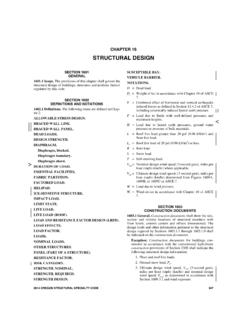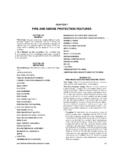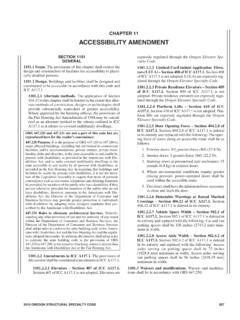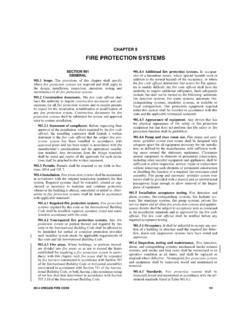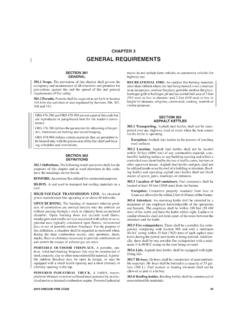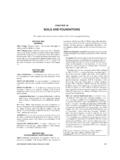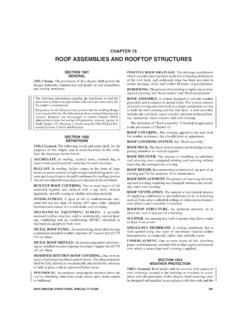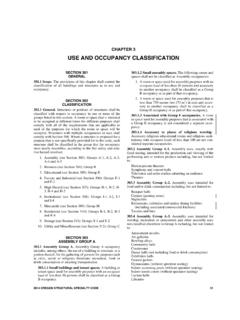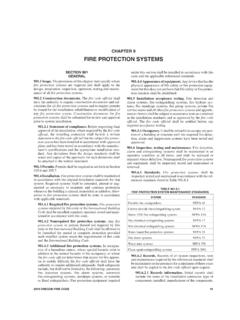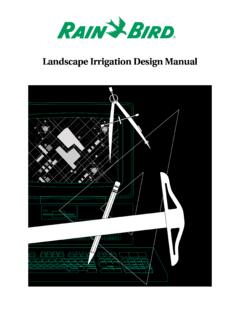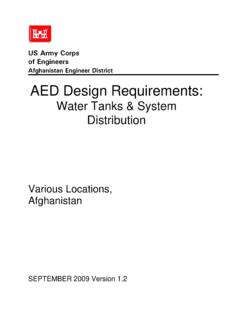Transcription of APPENDIX P SIZING OF WATER PIPING SYSTEM
1 APPENDIX PSIZING OF WATER PIPING SYSTEM (Not Adopted by the State of Oregon)(The provisions contained in this APPENDIX are not mandatory unless specifically referenced in the adopting ordinance.)SECTION APPENDIX outlines two procedures for siz-ing a WATER PIPING SYSTEM (see Sections ). The design procedures are based on the mini-mum static pressure available from the supply source, thehead charges in the SYSTEM caused by friction and elevation,and the rates of flow necessary for operation of various of the variable conditions encounteredin hydraulic design, it is impractical to specify definite anddetailed rules for SIZING of the WATER PIPING SYSTEM .
2 Accord-ingly, other SIZING or design methods conforming to goodengineering practice standards are acceptable alternatives tothose presented AP102 INFORMATION the necessary informationregarding the minimum daily static service pressure in the areawhere the building is to be located. If the building supply is tobe metered, obtain information regarding friction loss relativeto the rate of flow for meters in the range of sizes likely to beused. Friction loss data can be obtained from most manufactur-ers of WATER Demand the supply demand of the buildingmain and the principal branches and risers of the SYSTEM bytotaling the corresponding demand from the applicable partof Table (3).
3 Continuous supply demands in gallonsper minute (L/m) for lawn sprinklers, air conditioners, etc.,and add the sum to the total demand for fixtures. The resultis the estimated supply demand for the building AP103 SELECTION OF PIPE from Table what is thedesirable minimum residual pressure that should be main-tained at the highest fixture in the supply SYSTEM . If the highestgroup of fixtures contains flush valves, the pressure for thegroup should not be less than 15 pounds per square inch (psi)( kPa) flowing.
4 For flush tank supplies, the available pres-sure should not be less than 8 psi ( kPa) flowing, exceptblowout action fixtures must not be less than 25 psi ( kPa) Pipe sizes can be selected according to the fol-lowing procedure or by other design methods conforming toacceptable engineering practice andapprovedby theadministrative authority. The sizes selected must not be lessthan the minimum required by this pipe SIZING procedures are based on a sys-tem of pressure requirements and losses, the sum of whichmust not exceed the minimum pressure available at the sup-ply source.
5 These pressures are as follows:1. Pressure required at fixture to produce required Sections of this code and Section theInternational Plumbing Static pressure loss or gain (due to head) is computedat psi per foot ( kPa/m) of elevation :Assume that the highest fixture supplyoutlet is 20 feet (6096 mm) above or below the sup-ply source. This produces a static pressure differ-ential of psi ( kPa) loss [20 feet by (2096 mm by kPa/m)].3. Loss through WATER meter. The friction or pressureloss can be obtained from meter Loss through taps in WATER Losses through special devices such as filters, soften-ers, backflow prevention devices and pressure regula-tors.
6 These values must be obtained from Loss through valves and fittings. Losses for theseitems are calculated by converting toequivalentlengthof PIPING and adding to the total pipe Loss caused by pipe friction can be calculated whenthe pipe size, the pipe length and the flow through thepipe are known. With these three items, the frictionloss can be determined. For PIPING flow charts notincluded, use manufacturers tables and velocity :For all examples, the following metric conversionsare applicable:1 cubic foot per minute = L/s1 square foot = m21 degree = rad1 pound per square inch = kPa1 inch = mm1 foot = mm1 gallon per minute = L/m2011 OREGON RESIDENTIAL SPECIALTY CODEP-11M:\data\CODES\STATE CODES\Oregon\2011\Residential\Final VP\ , April 20, 2011 1:33:49 PMColor profile.
7 Generic CMYK printer profileComposite Default Segmented loss size of WATER servicemains, branch mains and risers by the segmented loss method,must be determined according to WATER supply demand [gpm(L/m)], available WATER pressure [psi (kPa)] and friction losscaused by the WATER meter anddeveloped lengthof pipe [feet(m)], includingequivalent lengthof fittings. This design proce-dure is based on the following parameters: The calculated friction loss through each length of thepipe. A SYSTEM of pressure losses, the sum of which must notexceed the minimum pressure available at the streetmain or other source of supply.
8 Pipe SIZING based on estimated peak demand, total pres-sure losses caused by difference in elevation, equip-ment,developed lengthand pressure required at themost remote fixture, loss through taps in WATER main,losses through fittings, filters, backflow prevention de-vices, valves and pipe of the variable conditions encountered in hydraulicdesign, it is impractical to specify definite and detailed rules forsizing of the WATER PIPING SYSTEM . Current SIZING methods donot address the differences in the probability of use and flowcharacteristics of fixtures between types of occupancies.
9 Creat-ing an exact model of predicting the demand for a building isimpossible and final studies assessing the impact of WATER con-servation on demand are not yet complete. The following stepsare necessary for the segmented loss the necessary information regard-ing the minimum daily static service pressure in the areawhere the building is to be located. If the building supplyis to be metered, obtain information regarding frictionloss relative to the rate of flow for meters in the range ofsizes to be used. Friction loss data can be obtained frommanufacturers of WATER meters .
10 Enough pressure must beavailable to overcome all SYSTEM losses caused by fric-tion and elevation so that plumbing fixtures operateproperly. Section of theInternational PlumbingCoderequires that the WATER distribution SYSTEM bedesigned for the minimum pressure available taking intoconsideration pressure fluctuations. The lowest pressuremust be selected to guarantee a continuous, adequatesupply of WATER . The lowest pressure in the public mainusually occurs in the summer because of lawn sprinklingand supplying WATER for air-conditioning cooling demands placed on the public main as a result oflarge growth or expansion should also be available pressure will decrease as additional loadsare placed on the public Demand the supply demand of the build-ing main and the principal branches and risers of the sys-tem by totaling the corresponding demand from theapplicable part of Table (3).
